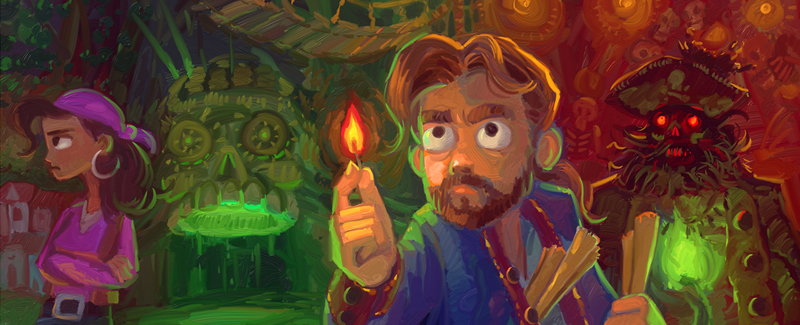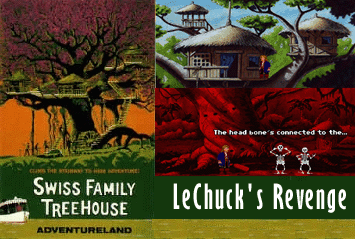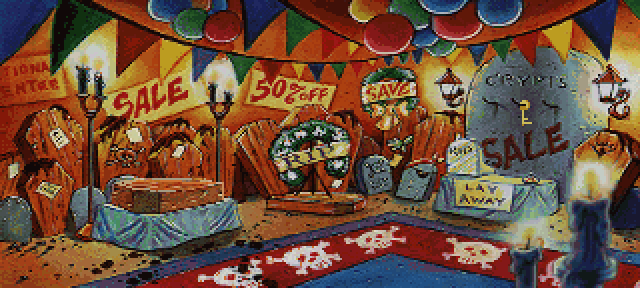Articles

LucasArts' Secret History #6: Monkey Island 2: LeChuck's Revenge Trivia
Some trivia for you...
The game's ending in conjunction with the numerous Disneyland references throughout the game have led many fans to subscribe to the theory that the titular Secret of Monkey Island is in fact what the ending of Monkey Island 2 suggests: that all of Guybrush's adventures have been the fantasies of a child who got lost from his parents in an amusement park. This explains the appearance of the E-ticket, the Disneyland-like underground tunnels, the anachronisms, the self-aware nature of the games (such in Monkey Island 1 when one of the pirates tells Guybrush: "Pirate lingo! It's how everybody talked back then. Come on Guybrush, play along"), all the reference to the Pirates of the Caribbean ride, and several other allusions. For further reading on the subject we recommend this article, originally published at The SCUMM Bar.
The ending to this game is how Ron Gilbert originally wanted to end The Secret of Monkey Island, before the team talked him out of it. As the two games were made back-to-back, several ideas originally intended for Monkey Island 1 that were cut were carried over to the sequel.

Like the original game, Monkey Island 2 features several references to the theme park ride that inspired it, most blatantly Guybrush's efforts to retrieve a jail key from a dog with the use of a bone. The dog's name, according to one of the characters in the game as well as the ending credits, is Walt. There are also innumerable references to the Disneyland theme park as a whole.
Space constraints were a huge problem for this lengthy game, which came on a whopping eleven floppy disks. Several significant "scenes" from the game apparently had to be cut to remain within the limit. According to Ron Gilbert, his most regretted cut was a third, medium difficulty option from the game, which he feels would have addressed the common complaint about the game's challenge, which was often considered too high in Regular mode but too low in Lite mode.
Disk swapping was a rather big nuisance if you were playing on the hard drive deprived Amiga. For example, in the scene where Largo spits in the bar, a disk swap must be made both before and after the close-up of the glob of flying green spit.
This is the first LucasArts game in which backgrounds could be scanned from hand-drawn sources. Although the primitive nature of the technology resulted in a rather pixellated final product, the painting artwork remains hugely impressive.
When LucasArts celebrated its 20th anniversary online, it provided a gallery of concept art for its older games. Among these were some of the original illustrations for Monkey Island 2, which can be seen here, here, and here.
Dave Grossman joined the project a bit late because he was working with Noah Falstein on an early design for The Dig, the long and torturous history of which we'll get into once that game's time comes.
Like Monkey Island 1, this game came packaged with a copy-protection code wheel called the "Mix ‘n' Mojo Voodoo Ingredient Proportion Dial." Upon startup the game would ask you for the proper amount of two ingredients for a fictional voodoo recipe, which you had to correctly supply before you could play the game. (And yes, this, along with the Voodoo Lady's place of business, is the origin of the name of the web site you're reading.
)
The LucasArts logo can be seen hidden in the background art when Guybrush arrives at LeChuck's fortress.
This was the first adventure game to sport the "LucasArts" name and logo, the result of the Lucasfilm games division being reorganized.
There are several Star Wars and Indiana Jones movies references throughout the game, ranging from quotes, site gags, and music cues, and most of them are too obvious to list.
The Ctrl+Alt+W "Are you sure you want to win?" gag is repriced here, and if you perform it after blowing the hole on Dinky Island Guybrush will appear next to Elaine in her scene during the credits, where he will say "What am I doing standing next to this hole?"
This was the last game that project leader Ron Gilbert would serve on for the company. Shortly afterward he and producer Shelley Day left LucasArts to found Humongous Entertainment, perhaps best known for its own SCUMM powered graphic adventure games, these aimed at children. Dave Grossman would work on many of these adventure games.
One of the most popular parts of the original game was the insult sword fighting segment. Not wanting to simply rehash this, the team had hoped to create a spiritual successor to that idea in Monkey Island 2, but never came up with one they were happy with. Future sequels would prove less unwilling to revisit the concept.
The name of the character Kate Capsize is likely a reference to actress Kate Capshaw, wife of Steve Spielberg (and best known as Willie Scott in Indiana Jones and the Temple of Doom). Spielberg was reportedly a fan of the Monkey Island games. For some good lines one should attempt to "Pick up" Kate several times.

Steve Purcell's comic characters continue their tradition of cameo appearances in this game, with Max appearing in apparel form in the Booty Island costume shop.
If you have Guybrush attempt to open the telescope, he will respond by saying, "This isn't Monkey Island 1."
The majority of the headstones in the Scabb Island cemetery have humorous epitaphs written on them, similar in vein to what you would find in the waiting line of Disneyland/Disneyworld's "The Haunted Mansion" ride.
The two pirates at the campfire are named Bart and Fink, which may be a reference to the Coen Brothers film Barton Fink which came out around the time of the game's development.
The "Lite" version of the game doesn't just cut out puzzle sequences from the "Regular" mode – it alters some things. For example, the clean, white sheet inventory item (which replaces the harder-to-get article of clothing in Regular mode) is exclusive to Lite mode.
One of the character designer/animators on this game was rookie employee Larry Ahern, who would go on to become the co-project leader of the third Monkey Island game.
This game is significant for introducing an extremely revolutionary music engine called iMUSE, invented by Peter McConnell and Michael Land, which allowed music to reflect the action on screen in a fluid and dynamic way. iMUSE was extremely influential and would be used to varying extents in all of LucasArts' adventure games, but Monkey Island 2 is often considered to be the best use of it.
The book descriptions in the Phatt Island Library card catalog are filled with in-jokes.
The line "I was just transferred here today. New orders," that Guybrush can tell the mysterious man behind the door in the alleyway is a line from Indiana Jones and the Last Crusade: The Graphic Adventure.
Similar to the drowning gag in Monkey Island 1, it is possible for Guybrush to "die" in this game if you remain hanging in LeChuck's death trap for several minutes, allowing the candle to burn through the rope.. This will lead to Guybrush being lowered into the acid pit, prompting the game to cut back to the frame story with Elaine and Guybrush hanging above a chasm. Elaine calls Guybrush out on the embellishment, and the game returns to Guybrush and Wally hanging over the acid.
A scene in which Wally drowns when going after his monocles which falls off his makeshift raft as Guybrush flies through the air following the explosion of LeChuck's fortress was cut out when it was deemed too mean spirited. The character's cameo at the beginning of the third Monkey Island game provides the character with a happier fate.
One of the questions you can ask LeChuck while hanging over the acid pit is "Why do adventure games cost so much?" to which he replies, "Scanned VGA art is very expensive."
Be sure to check Guybrush's Wanted poster throughout the course of the game to check on all of the felonies you rack up.
The CD version of the game (most commonly played as a part of the Monkey Island Madness compilation disc) did not add any new features, but it did oddly remove the difficulty selection screen, instead going straight to the beginning of Regular mode. Our own Benny explains.
The reason why MI2 sometimes was missing the difficulty mode was because in version with no copy protection they used the 10001 boot param - which skips protection but also takes you straight into hard mode.
For more fun with boot parameters, check out this forum thread.
The Bloody Lip bar cook is named Bernard, which may be a reference to the Maniac Mansion character of the same name.
Steve Purcell keeps the original illustration of the game's cover art framed in his home, and sold the art seen on the back of the game's box for a rather tidy sum.
Get lost on Dinky Island, and you might run into a phone that dials the LucasArts Helpline. Here you can talk to Chester,who gripes about people not getting the infamous "stump joke" in MI1, and called him complaining about the "missing"disk #22. This was, of course, based on actual events.